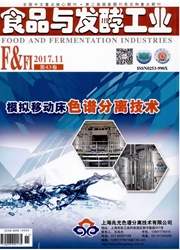

 中文摘要:
中文摘要:
通过几种不同原料制备的甘油对克雷伯杆菌厌氧发酵生产1,3-丙二醇的影响的比较实验,验证了两步发酵法生产1,3-丙二醇工艺路线的可行性。在甘油初始浓度相同(70g/L)的条件下,以葡萄糖为原料进行发酵得到的甘油转化为1,3-丙二醇的效果较好,发酵15h,甘油转化为1,3-丙二醇的摩尔转化率为45.1%;皂化甘油生产1,3-丙二醇的发酵时间为18h,摩尔转化率为44.2%;而以玉米淀粉水解液发酵的甘油转化为1,3-丙二醇需要31h,摩尔转化率仅为26.5%。
 英文摘要:
英文摘要:
An investigation of microbial production of 1,3-propanediol in a two-stage fermentation by using glucose or cornstarch as raw material was carried out in this work. In comparison with the anaerobic batch fermentation of 1,3-propanediol from saponified glycerol, the bioprocess of two successive microbial fermentations for the production of 1,3-propanediol was feasible. The yield of 1,3-propanedio was higher than that of 1,3-propanediol directly from saponified glycero with 15 h in the two-stage fermentation in a 18h batch fermentation. The molar yields of 1,3-propanediol to glycerol were 47.3 % and 44.2 %, respectively, at the same initial glycerol concentration of 70 g/L. The final concentration of 1,3 propanediol in a two-stage fermentation from glucose was 24.8 g/ L. This is almost same as that from saponified glycerol in single batch fermentation (24.2 g/L). However, the conversion rate of glycerol produced from the first stage using cornstarch to 1,3-propanediol from the second stage was only 26.5 % (mol/mol) in 31h and the final concentration of 1,3-propanediol was 13.4 g/L. The productivity of 0.43 g/(L· h) of the second stage was much lower than that of a two-stage-fermentation from glucose (1.65g/ L) or of single fermentation from saponified glycerol, which is 1.34g/L.
 同期刊论文项目
同期刊论文项目
 同项目期刊论文
同项目期刊论文
 期刊信息
期刊信息
